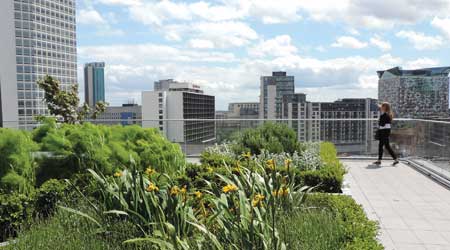How to Add Value on Your Next Roofing Project
Advancements in roofing technology provide opportunities for gains in energy efficiency.
When it comes time to replace a roof, a facility manager should not automatically replace it in kind or base decisions solely on the lowest bid results. The new roof system should be chosen based on its ability to enhance other aspects of a building’s resilience, sustainability, wellness strategies, and long-term durability. Selection of a roof system based on the overall functional objectives of the building will provide continuous value over the life of the structure.
The durability of the roof materials is always an important consideration. Roof materials have changed considerably in the last 30 years due to labor shortages, environmental regulations, and insurance requirements. These changes primarily impacted material attachment methods. Proper roof selection now not only includes determining the best roof membrane system, but also determining the proper attachment method for the building.
Because the roof is one of the largest exterior components, it is also one of the most expensive to maintain over the lifespan of the building. Therefore, selection of a roof system should not be based primarily on initial low cost. The ultimate cost considerations should be based on a roof system’s long-term performance, which should include limited annual maintenance requirements and affordable repair methods. Initial cost savings will be deferred if the roof system has a shortened lifespan or requires extensive annual maintenance and repair costs.
Beyond these basic requirements, facility managers can use the new roof system to add value to their facility in two additional areas:energy efficiency and occupant wellbeing.
Improving energy efficiency
Energy-efficient roof systems and sustainability have significantly advanced over the past two decades. Regulations and facility manager sentiments have made these issues top priorities in roof buying decisions. Recent advancements in materials, methods, and design of system components have emphasized energy efficiency. Roof systems have an impact on energy-efficiency through thermal capacity, emissivity, and reflectivity.
The biggest deterrent to energy efficiency at the building envelope is heat loss at exterior components. Because roofs are often the largest exterior component, implementing methods to decrease (or eliminate) heat loss at the roof system is the best way to contribute to overall building performance. Roof systems can eliminate heat loss through the application of proper thermal insulation and membranes with sufficient emissivity rates.
In roof systems, thermal capacity is achieved through installation of an insulation system with high long-term thermal resistance (LTTR) values. In commercial, low-slope roof systems, the insulation is a rigid board that is applied above the deck. High LTTR insulation will reduce heat loss in the winter months, which decreases heating costs through the use of lower energy capacity.
The adoption of ANSI/ASHRAE 189.1 standard for the Design of High-Performance Green Buildings to the International Building Code in 2007 provided, for the first time, the required insulation LTTR-Values for all low-slope commercial roof systems. The LTTR values are based on the thickness of the insulation and are defined in the standard based on the geographic region of the building. Through this standard, the thickness of insulation required in the roof system has increased.
Emissivity keeps heat from leaving the building by subverting its exit as it rises to the roof level. In roof systems, this is achieved through a combination of insulation and the membrane material. The LEED emissivity rating for a roofing membrane is a minimum of .90 based on ASTM E408.
Energy efficiency also can be gained through proper reflectivity of the surfacing of the membrane material. In contrast to emissivity, which keeps heat from leaving the building, reflectivity keeps outside heat (from the sun) from entering the building. Reflective roof surfaces can be achieved through light-colored membranes or installation of coatings or other reflective surfacing materials. Reflective surfaced roofs can reduce surface temperature by as much as 30 percent and can extend the service life of some membrane systems by reducing expansion and contraction. Studies have indicated that reflective surfaces will cool the building in the summer, thereby decreasing the use of air conditioning, which decreases cooling costs and energy capacity.
Proper roof design should include required insulation thickness, proper attachment methods, and required rates of attachments. It would also be advisable to conduct dew point calculations for proper emissivity rates to eliminate condensation in the insulation system. If a coating is applied, make certain that it is compatible with the membrane and that all preparation requirements are properly completed. Application should be in compliance with the manufacturer’s requirements.
Related Topics:














